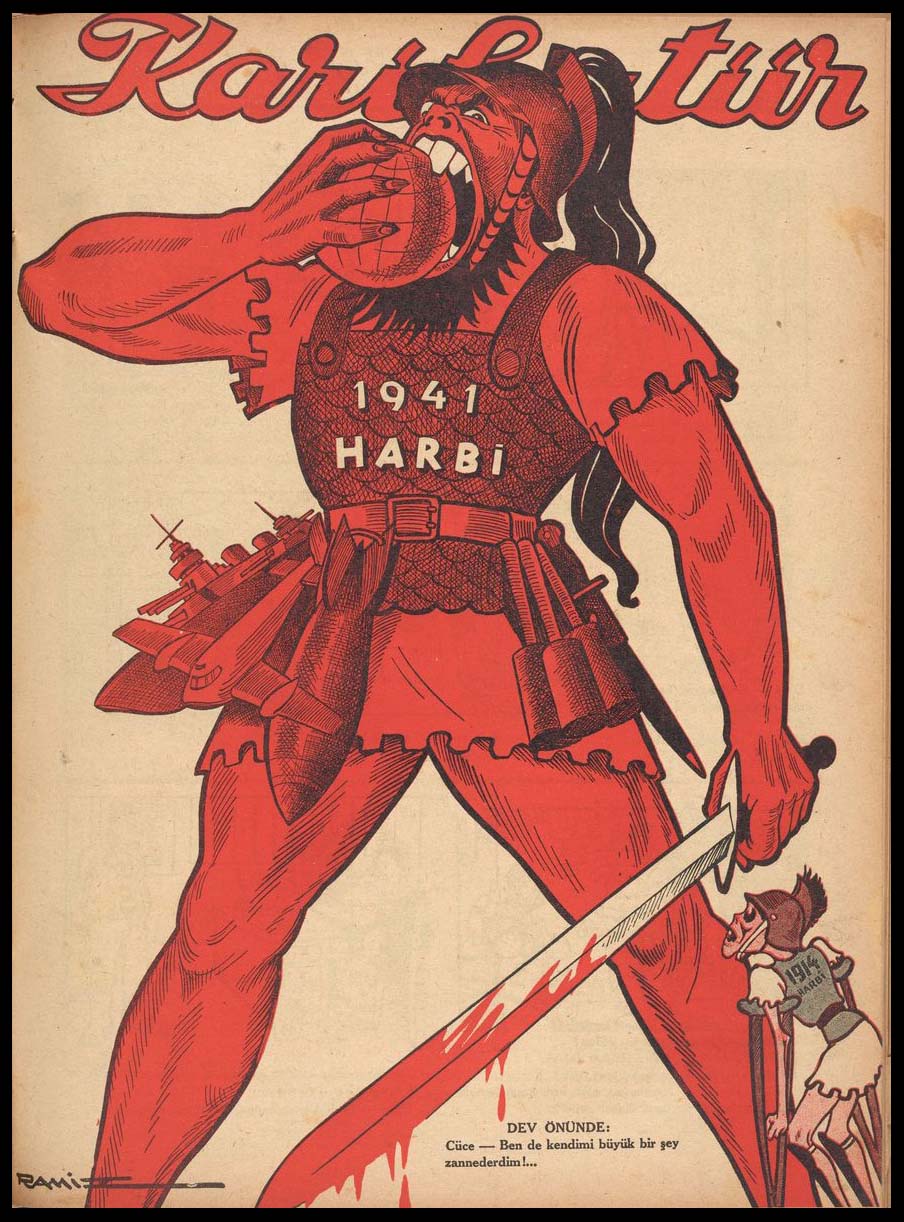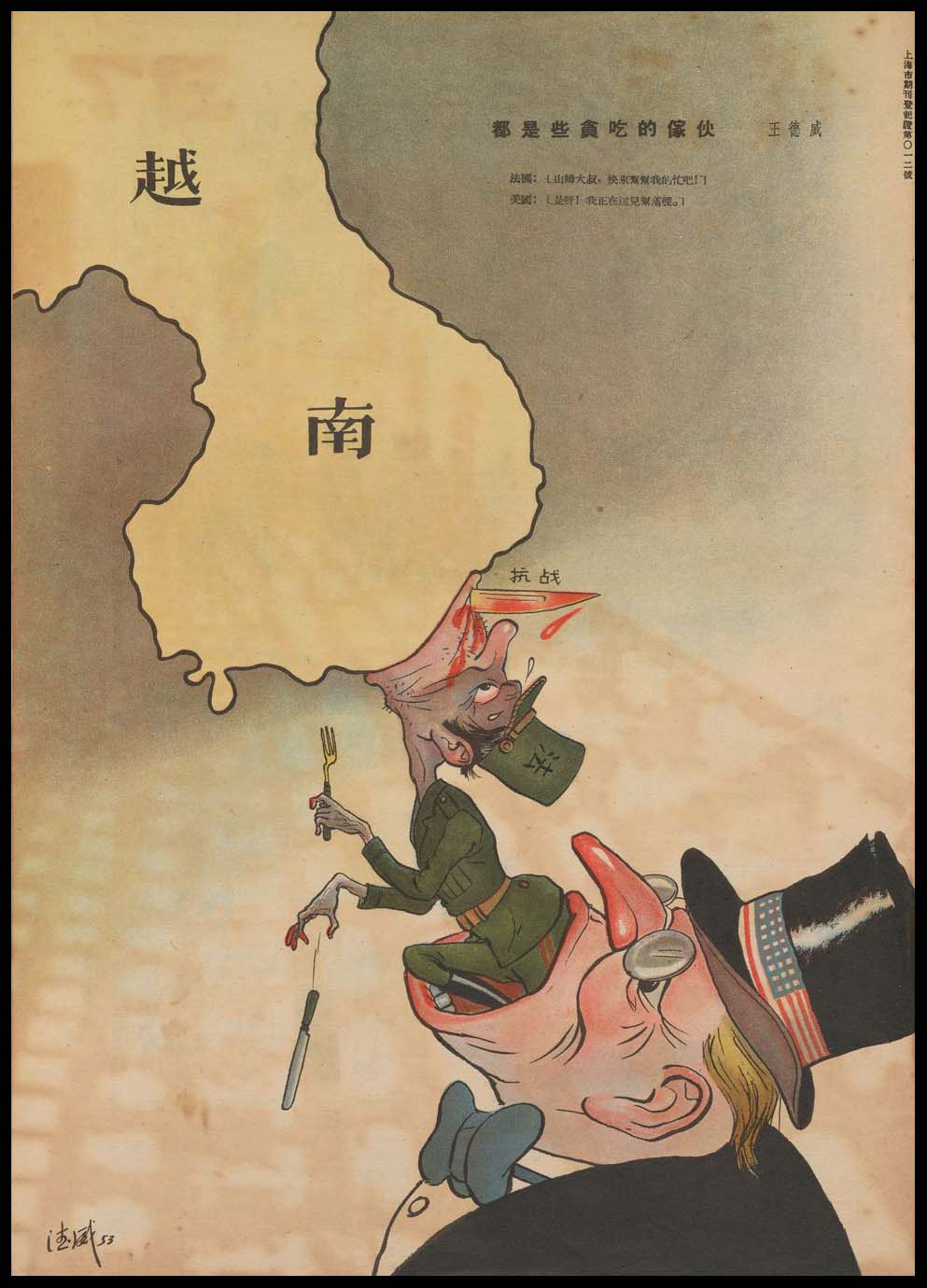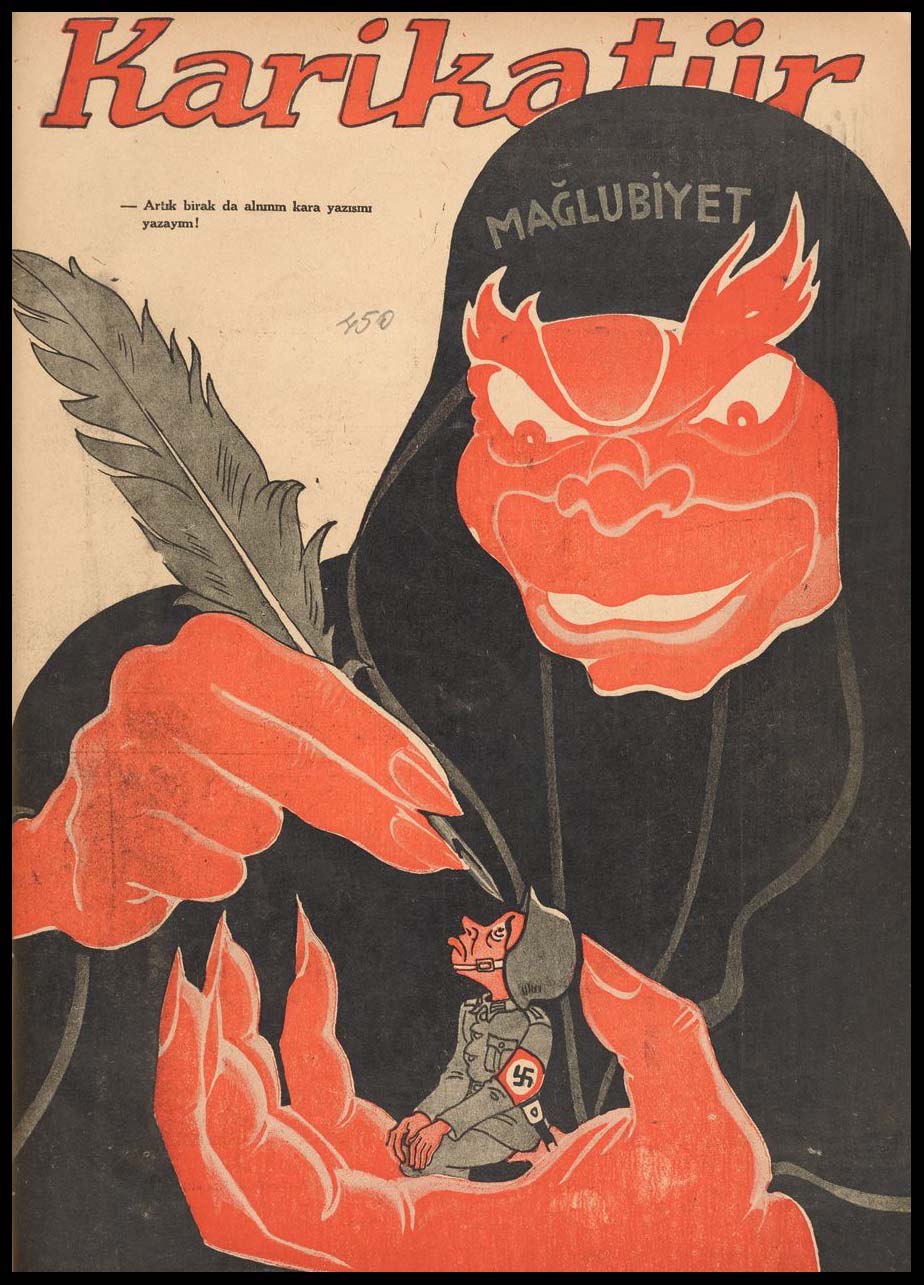Titans and Tyrants

Human figures of gigantic scale and outsize humanoid monsters are expressions of self-aggrandizing hubris and overreach, embodying an immoral, perverse transgression of the proper limits of an individual human being. In some cases these gigantic monsters are also shown devouring or threatening to devour other human beings of normal dimensions. This strategy is frequently used to represent dictators or other tyrannical figures. These images resonate with and often derive from scriptural, folkloric, and mythological traditions, including, for instance, the giants of Greek mythology who challenged the gods and the Old Testament giant King Nimrod who challenged the divine order by building the Tower of Babel in an effort to reach the heavens. The horrors wrought under tyrannical autocrats around and after World War II make the giant a crucial figure of the imaginary of twentieth-century visual satire.
Dev Önünde: Cüce - Ben de kendimi büyük bir şey zannederdim…
(in front of the Giant, the Dwarf - [And] I used to think of myself as something great!...), 18 Birinci Kânun/December 1941
Ramiz Gökçe (1900-1953)
Karikatür, vol. 12, year 6, no. 312
Türkiye, Turkish
The war of 1941 (World War II) is represented as a demon giant eating the world, while a smaller skeleton labeled War of 1914 (World War I) looks on. Published mere days after the Japanese attack on Pearl Harbor, this would have been the front-page image Turkish readers saw in the periodical Karikatür nine days after the United States joined the war (December 9, 1941).
都是些貧吃的傢伙
(These guys are poor eaters), 1953
王德威 (Wang Dewei), dates unknown
漫畫 (Man hua) 36, Back cover, November 15, 1953
China, Chinese
In 1953, the United States aided France’s effort to suppress the Việt Minh liberation movement and re-establish control over the former French colony. America was widely seen as pursuing its own imperialist agenda. This drawing shows France clinging to its colonial hold on Vietnam. Suctioned on to the country with its small mouth pierced by the blade of the armed resistance, the French figure realizes it has bitten off more than it can chew. It calls to the larger, more powerful America to help it devour Vietnam, unaware that that larger colonial power is poised to swallow France itself.
Amerikan Çikleti
(American chewing gum), 25 Ocak/January 1945
Ramiz Gökçe (1900-1953)
Karikatür, vol. 19, year 10, no. 474
Türkiye, Turkish
America, as giant Uncle Sam, chews Japan, represented by a man with stereotyped East Asian features wearing a hat with the imperial seal of Japan, a chrysanthemum. The latter’s stature diminishes Japan’s power. Turkey had severed ties with Japan mere weeks before (January 6, 1945) this issue was published. The caricaturist sees the United States as an imposing and invincible giant and as an ally, eating its enemies during the war.
Pax Britannica, 1943
Giulio Bertoletti (1919-1976)
Italy, Latin
Just like Uncle Sam personifies the United States, John Bull is the national personification of England. This poster depicts what a Pax Britannica would look like should the Axis lose the war. John Bull has devoured the entire world and is stepping over the corpses of dead civilians while fires burn in the background.
Boğazımızda gözü olanlara Tehlikeli bir Boğaz
(A dangerous Strait to those who have their eyes on our throat), 20 Eylül/September 1945
Ramiz Gökçe (1900-1953)
Karikatür, vol. 20, year 10, no. 508
Türkiye, Turkish
A man, possibly Soviet, looks down the throat of a Turkish soldier, a giant figure representing the Turkish military. Throat here is a play on words, since the Bosphorus (Straits) is called ‘the throat’ in Turkish: ‘Boğaz.’ The Turkish Straits crisis came to a head during this time, with the Soviet Union pressuring Turkey to allow Soviet passage and joint military control through the straits.
和平的窗户
(The Window of Peace), 1960s
Artist unknown
China, Chinese
The American man’s toothy mouth is a proscenium framing a dinner table set for two — a trap baited with the promise of peace. The vase containing an olive branch surrounded by dollar-sign flowers belies the ostensible agenda of ending hostilities and signals a true agenda of continued military aggression and profit. In the mid-1960s, United States President Lyndon Johnson announced he would pursue “unconditional talks” for peace in Southeast Asia, which was widely seen as a hypocrisy of an aggressively expansionist power, expressed here in the gigantism of the American figure.
Artık birak da anımın kara yazızını yazayım
(Let me now write [seal] your dark destiny on your forehead), 10 Ağustos/August 1944
Ramiz Gökçe (1900-1953)
Karikatür, vol. 18, year 9, no. 450
Türkiye, Turkish
A red giant with “mağlubıyet” (defeat) written on its forehead readies to write the same on the Nazi in its palm. There is a Turkish belief that your destiny is written on your forehead. When someone is struck with misfortune, it is described as ‘the black script on one’s forehead,’ meaning their unfortunate fate.
با اين دو (فک) جنايتکار مملکت را بلع ميکند! در حاليکه دندانها هم تبابهم فحش ميدهند
(With these jaws, The criminal will swallow the country! while the teeth keep cursing each other), 10 Bahman 1326/31 January 1948
Artist unknown
Mard-i Imrūz. year 6, no. 136
Iran, Persian
The demon giant eats people using a fork that reads city police (شهر بانى), justice (دادگسترى), and military law enforcement (ژاندارمرى) and a knife that says [Iranian] military (آرتش).The teeth could be Hitler, Stalin, Hirohito, Mussolini, Mao, and others, or top Iranian officials squabbling with each other, including Sardar Fakher Hekmat (Speaker of the Majles/House of Representatives, former Prime Minister), Ebrahim Hakimi (Prime Minister), Malek al-Sho'arā-ye Bahār (poet and cabinet member), and Qavām-e Saltaneh (former Prime Minister).
Untitled, undated (1948-1950)
Chakor (pen name of Bansilal Verma), 1917-2003
India, Gujarati
The text on the arm’s sleeve reads સિંધ સરકારનો સ્થાવર જંગમ કબજા કાયદો (Confiscation of Immovable Property Act of the Government of Sindh), referring to the Evacuee Property Act of 1948 or 1950. This legislation was meant to hold property in trust for original owners after partition (when India and Pakistan were split), but in effect evacuee property law in both countries became a means to confiscate minority-owned property and redistribute it.
Взрывать надо!
(Blow him up!), undated, late 1980s
Валерий Анатольевич Завьялов (Valerii Anatol’evich Zav’ialov) (1936-2001)
Вольт Николаевич Суслов (Vol’t Nikolaevich Suslov) (1926-1998) — author of verse text
Russia, Russian
A representation of the Communist party bureaucrat as an outsize, immovable stone monument to self-importance, obstructionism, and petty tyranny. The poster almost certainly dates to the late 1980s, when the policies of glasnost and perestroika encouraged open criticism of the Soviet state and Soviet society. Before this, Soviet bureaucrats would not have been eligible satirical targets. The verse text reads: “Imperiousness, party-arrogance, self-importance —/ This is the arsenal of the bureaucrat./ He can be difficult to defeat,/ But there is a way!/ Blow him up!”









